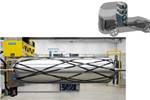Cathay bio-based continuous TPC enables aviation container airworthiness certification
RAP-AT1 active aviation temperature-controlled container passed CAAC review and earned authorization for commercialization, driving China’s aviation cold chain equipment sector.
Source | Cathay Industrial Biotech Ltd.
’s (Shanghai, China) low-carbon, high-performance continuous fiber-reinforced thermoplastic bio-based polyamide composites enabled an aviation temperature-controlled container — used for temperature-sensitive cargo during air transport — to pass the Civil Aviation Administration of China’s (CAAC) airworthiness review.
The RAP-AT1 active aviation temperature-controlled container was developed by Qingdao HB TempCon Aviation Co. Ltd. (HB TempCon), a subsidiary of Haier Biomedical. Cathay Industrial’s supply of composite materials ensured the container’s lightweight design, thermal insulation and structural strength. These materials also target significantly reduced energy consumption and carbon emissions in aviation transportation while maintaining high thermal efficiency and wear resistance.
In January, the innovation passed CAAC airworthiness review, in addition to obtaining the Technical Standard Order Authorization (CTSOA), marking its official entry into the commercial phase, and a technological breakthrough for China’s aviation cold chain equipment sector.
Cathay Industrial engages in the research, development, production and sales of novel bio-based aterials based on synthetic biology, among other disciplines. The company’s bio-based composite material — referred to as bio-PPA CFRT — is reported to be a novel thermoplastic composite. Its matrix resin can use various types of bio-based polyamides, including low-temperature, long-chain, medium-temperature and high-temperature grades. Due to its optimal melt flowability, the material enables high loading ratios of continuous glass/carbon fibers, achieving strength/modulus comparable to metals while maintaining a density of only a quarter of steel’s density and two-thirds of aluminum’s density, with significantly lower carbon emissions. The material being a thermoplastic also makes it inherently recyclable.
With broad application prospects in sectors such as new energy, construction and transportation logistics, the company believes that this material is poised to replace metals (for example “plastic for steel” and “plastic for aluminum”) as well as thermoset materials with thermoplastics in large structural components.
Moving forward, Cathay Biotech will continue to collaborate closely with partners across industries, providing low-carbon, high-performance green and sustainable solutions to jointly drive industrial transformation and development in downstream sectors.
Related Content
-
Welding is not bonding
Discussion of the issues in our understanding of thermoplastic composite welded structures and certification of the latest materials and welding technologies for future airframes.
-
Industrializing additive manufacturing in the defense/aerospace sector
GA-ASI demonstrates a path forward for the use of additive technologies for composite tooling, flight-qualified parts.
-
Low-cost, efficient CFRP anisogrid lattice structures
CIRA uses patented parallel winding, dry fiber, silicone tooling and resin infusion to cut labor for lightweight, heavily loaded space applications.






